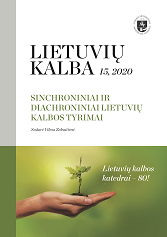APIE ADVERBIALINIUS SAKINIUS SAKYTINĖJE LIETUVIŲ KALBOJE
ON ADVERBIAL CLAUSES IN SPOKEN LITHUANIAN
Author(s): Erika Jasionytė-MikučionienėSubject(s): Language studies, Morphology, Lexis, Semantics, Baltic Languages
Published by: Vilniaus Universiteto Leidykla
Keywords: Lithuanian language; spoken language; adverbial clauses;
Summary/Abstract: The aim of the paper is to investigate adverbial clauses of time, cause, condition and concession in spontaneous private communication. The study explores semantic relations between the main and subordinate clauses, grammatical features and predominant conjunctions. The data for the research was collected from the morphologically annotated Corpus of Spoken Lithuanian, namely, its sub-corpus of spontaneous private speech which is used at home, at friends’ place, or which is produced by close friends. The analysis of spontaneous private communication shows that the finite adverbial clauses of time, cause, condition and concession are related to a set of conjunctions, but other indicators such as the use of verbal categories (especially tense, aspect and mood), contextual lexical markers as well as pragmatic inference also help to determine the semantic relationship between the main and the subordinate clause. In a spoken language, temporal clauses are usually combined with the conjunctions kai, kaip ‘when’, kol ‘while’, less frequently – with kada ‘when’; causal clauses are combined with the conjunction nes ‘because; since’, less frequently – with kad and kadangi ‘because’; conditional clauses are typically combined with the conjunction jeigu ‘if’, less frequently – with jei ‘if’, concessive clauses – with the conjunction nors ‘though’. The conjunctions kai ‘when’, kol ‘while’, kadangi ‘because’, jeigu and jei ‘if’ correlate with the particle tai that is very frequent in a spoken language, while the conjunction nors ‘though’ – with the contrastive conjunction bet ‘but’. In the natural language flow, the structure of adverbial sentences is modified: other sentential and discourse units can intervene between the main and the subordinate clauses, and the adverbial conjunction moves from the initial to the medial position. Traditional Lithuanian grammars emphasise that the position of adverbial clauses is undefined: they can appear before or after the main clause. However, the analysis of spontaneous speech shows that the position of a subordinate clause is influenced by the semantic relationship between the clauses. If a subordinate clause refers to a previous action or event, then it dominates in a preposition. Besides, the position of an adverbial clause is also influenced by correlative conjunctions: the main clause with the correlative particle tai dominates in the postposition. The research also revealed that Lithuanian adverbial clauses could function at the discourse level: in dialogues, the structure of a complex sentence is broken down and subordinate adverbial clauses can acquire additional – discourse – functions. Adverbial conjunctions, in their turn, can indicate relations with a previous discourse.
Journal: Lietuvių kalba
- Issue Year: 2020
- Issue No: 15
- Page Range: 1-25
- Page Count: 25
- Language: Lithuanian

